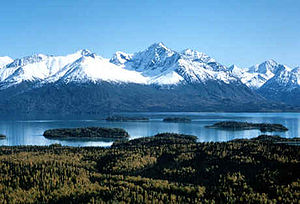Lake Clark
| Lake Clark | ||
|---|---|---|

|
||
| Lake Clark | ||
| Geographical location | Alaska (USA) | |
| Tributaries | Tlikakila River , Chulitna River , Currant Creek , Tanalian River , Kijik River , Chokotonk River | |
| Drain | Sixmile Lake → Newhalen River | |
| Places on the shore | Port Alsworth | |
| Data | ||
| Coordinates | 60 ° 15 ′ N , 154 ° 16 ′ W | |
|
|
||
| Altitude above sea level | 77 m | |
| surface | 370 km² | |
| length | 69 km | |
| width | 8 kilometers | |
| Maximum depth | 322 m | |
The Lake Clark is a large elongated lake in the southwest of the US state of Alaska on the west flank of the Aleutian Range .
Lake Clark is within the Lake Clark National Park and Preserve . The Tlikakila River flows into the northeastern end and the Chulitna River into Turner Bay on the northwest bank . At the southern end of the lake is the Sixmile Lake , which flows over the Newhalen River to Iliamna Lake . Lake Clark is about 64 km long and about 8 km wide and with an area of 370 km² one of the largest lakes in Alaska. It is up to 322 m deep. The water of Lake Clark is cloudy due to the suspended matter in the glacier water . At the northern end of the lake, the mouth of the Tlikakila River gradually cuts off the northernmost part of the lake, Little Lake Clark . The Chokotonk River flows into this .
Lake Clark was named after John W. Clark, who ran the Nushagak trading post from 1891. In Yup'ik , a native language , it was called "Kilchiq-vona".
particularities
In Lake Clark and in neighboring Lake Iliamna there is said to be a seven-meter-long creature ( white sturgeon ) that is believed to be responsible for the disappearance of several people.

